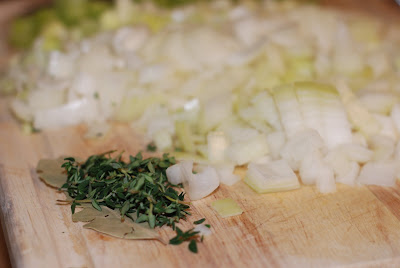
I've held out long enough. I hereby declare that it's Officially
Grillin' Season, even if I have to do it in a parka. (Not that I own a parka, it's just fun to say.
Parkuh.)
I love grilling on my
weber kettle
. It gets at the basics of good cooking--
caramelization, heat, and complementary flavors. Also, I get to set things on fire, enjoy the sunshine, and drink beer while I do it. Ever since I booted my 10
th-grade-boyfriend out of the way and cooked my first steak over a tiny camping grill, I've been addicted. I've also had a strict rule about letting boys near my fire. That sounds sort of wrong.
In celebration of
Grillin' Season, here are some quick tips and instructions for smoking food over a charcoal grill. It's not exhaustive or recipe-specific, but it'll take the mystery out of both grilling and smoking food and leave you a little room to experiment on your own.
1. Using a
charcoal chimney
: Remove the upper grate used as a cooking surface, but leave the smaller grate at the bottom of the grill in place. Open the vents on the bottom of the grill. Fill the chimney with coals and stuff tight balls of paper in the cavity underneath the coals. (This will make sure the paper lights on fire, rather than simply smolders and ashes.)
Light the paper on fire in several places and observe. If the coals smoke profusely, but you don't feel a significant source of heat after the smoking stops, carefully add more balls of paper to the smoldering paper underneath the chimney. Oxygen is important, so fan the paper underneath the chimney if it's a humid day, or if the breeze is light.
2. Soak your smoking wood chips of choice in water for at least a half hour. Soak longer if possible. I like to use 2 large handfuls of
mesquite wood.
3. Once the coals on the top of the chimney are mostly white, and the inner coals are glowing red, carefully dump half of the coals on one side of the lower grill, and half on the other, leaving the middle 1/3 of the lower grill empty. Add 4-5 fresh coals on top of the hot ones on either side. If you're smoking ribs, add an entire loose layer of fresh coals to keep your grill hot for the time it takes to smoke them.
3. Carefully place an empty aluminum casserole pan in the middle of your grill, between the hot coals. (And
Lordy, will they be hot!) Use long tongs to move the hot coals, if necessary.
Pour beer, fruit juice, and/or water into the pan to add flavor to the smoke and keep the drippings from charring. Add the wood chips on top of your charcoal, and replace the cooking-surface-grate.
Close the lid on your grill for 5 minutes, making sure the vents are open on the top to allow air to flow over the coals. (This will get the grill hot, so your food sears and is less likely to stick.) Add your food to the grill, placing it directly over the coals for 2-3 minutes. Here I'm using a smaller pork tenderloin, which has been marinated overnight in
Walkerswood jerk seasoning
.

4. Turn the meat, again placing it over the coals for 2-3 minutes and closing the lid.
If you desire more
caramelization on the surface of your meat (I certainly do--it tastes yummy and keeps the juices in) take your chances with taking the lid off and turning the meat frequently until you are just under your desired
doneness on the outside. Smoking will further caramelize the outside of your meat.

5. After the initial sear, move the meat to the center of the grill, over the pan of liquid. I smoked this 2 lb. pork tenderloin for 20 minutes and it was done perfectly. For smoking times on specific cuts and sizes of meat, comment below and I'll do my best to reply quickly with the proper smoking time after I check a number of sources. (One of them being my fantastic
Weber Cookbook
.)
6. To check the
doneness of your meat, PLEASE do not hack into it with a knife. Use the
Finger Test. Pork should be medium to medium-well.
7. Remove the meat from the grill and let sit for at least 10 minutes. On heating, all the juices in meat rush from the center, and if you cut it right away those juices will be released. If you let it rest, the juices are reabsorbed and your meat stays tender and flavorful.

8. Serve, and enjoy!
To counteract the extreme spice of the jerk seasoning, and to complement the
nutmeg and brown sugar flavors in the marinade, I made an orange bacon chutney to go with my smoked pork. I just fried up some bacon (a regular
occurrence in my household), sautéed some onion in the bacon grease,
deglazed the pan with orange juice, and added chicken stock, agave, and spices until everything tasted fantastic. Then I blended, and served.


































 Reduce heat and simmer until the potatoes are cooked--about 15 minutes. Remove 1/2 of the potatoes and mash them with a fork. Stir the mashed potatoes back into the soup. Add the cream, milk, and corn and simmer over low heat for 5 minutes.
Reduce heat and simmer until the potatoes are cooked--about 15 minutes. Remove 1/2 of the potatoes and mash them with a fork. Stir the mashed potatoes back into the soup. Add the cream, milk, and corn and simmer over low heat for 5 minutes. Add the fish and cook just until the it begins to flake--approx. 4 minutes.
Add the fish and cook just until the it begins to flake--approx. 4 minutes.

 I've held out long enough. I hereby declare that it's Officially
I've held out long enough. I hereby declare that it's Officially 




